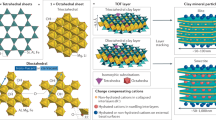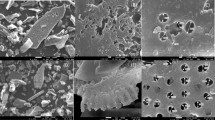Abstract
Michaelis and Ehrenreich1 were the first to suggest that the adsorption of large ions such as the organic dyes, on ionogenic surfaces, takes place by two distinct mechanisms operating simultaneously: one of an electrochemical nature, and in addition to this a ‘normal' physical adsorption. Later, Freundlich and Poser2 stated explicitly that the adsorption of large positive ions on clays could be explained qualitatively by the combined effects of an irreversible ion-exchange adsorption and a reversible physical adsorption, and this idea was further elaborated by Michaelis and Rona3. It is interesting for the historian of science that this simple idea was afterwards forgotten, but was ‘rediscovered' on several occasions prior to our work. The idea of simultaneous adsorption by two different mechanisms is not mentioned by Swan and Urquhart4 in their comprehensive review on adsorption, or in text-books. Even Freundlich himself in his "Kapillarchemie" (1930) seems to have lost sight of the implications and usefulness of the idea, but it was formulated in different ways by Stadnikoff5, Fogle and Olin6, Hendricks7 and Grim et al.8.
This is a preview of subscription content, access via your institution
Access options
Subscribe to this journal
Receive 51 print issues and online access
$199.00 per year
only $3.90 per issue
Buy this article
- Purchase on Springer Link
- Instant access to full article PDF
Prices may be subject to local taxes which are calculated during checkout
Similar content being viewed by others
References
Michaelis and Ehrenreich, Biochem. Z., 10, 283 (1908).
Freundlich and Poser, Kolloid Chem. Beihefte, 6, 297 (1914).
(a) Michaelis, L., and Rona, P., Biochem. Z., 97, 57 (1919); (b) 102, 268 (1920).
Swan and Urquhart, J. Phys. Chem., 31, 251 (1927).
Stadnikoff, Kolloid Z., 31, 19 (1922).
Fogle and Olin, Indust. Eng. Chem., 25, 1069 (1933).
Hendricks, S. B., J. Phys. Chem., 45, 65 (1941).
Grim, R. E., Allaway, W. H., and Cuthbert, F. L., J. Amer. Ceramic Soc., 30, 137 (1947).
For example, Seidell, A., J. Amer. Chem. Soc., 40, 312 (1918).
Gurwitsch, Z. physik. Chem., 87, 323 (1914).
Author information
Authors and Affiliations
Rights and permissions
About this article
Cite this article
PLESCH, P., ROBERTSON, R. Adsorption on to lonogenic Surfaces. Nature 161, 1020–1021 (1948). https://doi.org/10.1038/1611020a0
Issue Date:
DOI: https://doi.org/10.1038/1611020a0
This article is cited by
-
Mechanism of methylene blue dye adsorption on siliceous minerals
Kolloid-Zeitschrift und Zeitschrift für Polymere (1964)
Comments
By submitting a comment you agree to abide by our Terms and Community Guidelines. If you find something abusive or that does not comply with our terms or guidelines please flag it as inappropriate.



